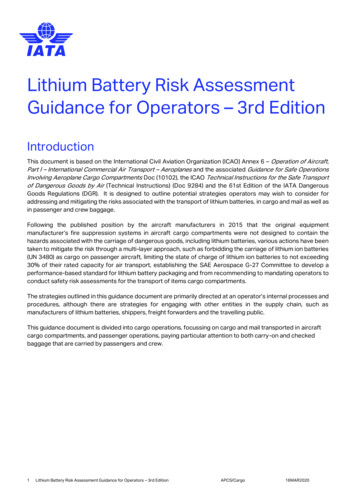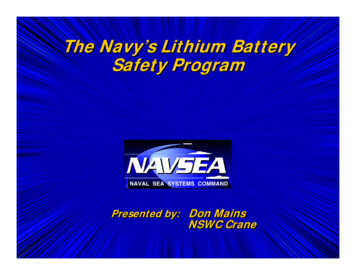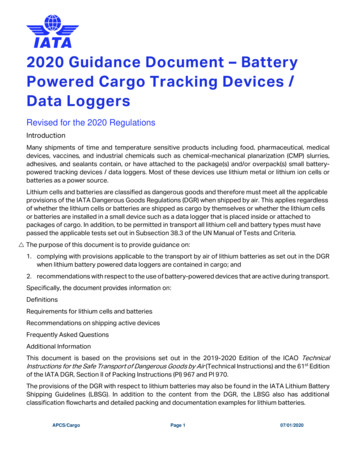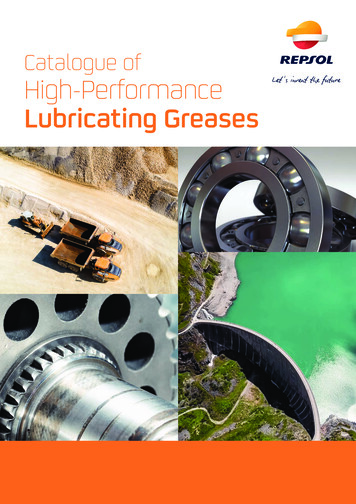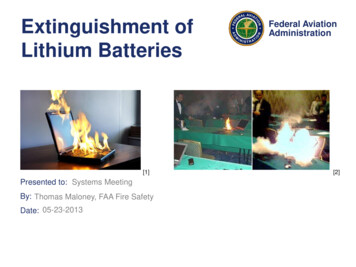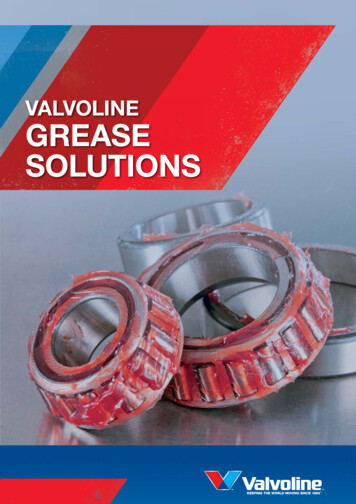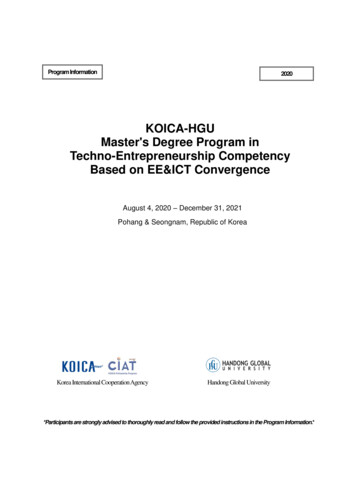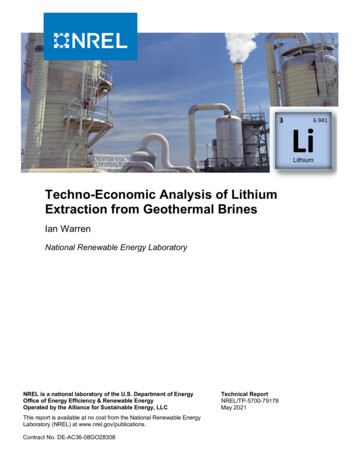
Transcription
Techno-Economic Analysis of LithiumExtraction from Geothermal BrinesIan WarrenNational Renewable Energy LaboratoryNREL is a national laboratory of the U.S. Department of EnergyOffice of Energy Efficiency & Renewable EnergyOperated by the Alliance for Sustainable Energy, LLCThis report is available at no cost from the National Renewable EnergyLaboratory (NREL) at www.nrel.gov/publications.Contract No. DE-AC36-08GO28308Technical ReportNREL/TP-5700-79178May 2021
Techno-Economic Analysis of LithiumExtraction from Geothermal BrinesIan WarrenNational Renewable Energy LaboratorySuggested CitationWarren, Ian. 2021. Techno-Economic Analysis of Lithium Extraction from GeothermalBrines. Golden, CO: National Renewable Energy Laboratory. sti/799178.pdf.NREL is a national laboratory of the U.S. Department of EnergyOffice of Energy Efficiency & Renewable EnergyOperated by the Alliance for Sustainable Energy, LLCTechnical ReportNREL/TP-5700-79178May 2021This report is available at no cost from the National Renewable EnergyLaboratory (NREL) at www.nrel.gov/publications.National Renewable Energy Laboratory15013 Denver West ParkwayGolden, CO 80401303-275-3000 www.nrel.govContract No. DE-AC36-08GO28308
NOTICEThis work was authored by the National Renewable Energy Laboratory, operated by Alliance for SustainableEnergy, LLC, for the U.S. Department of Energy (DOE) under Contract No. DE-AC36-08GO28308. Fundingprovided by the U.S. Department of Energy Office of Energy Efficiency and Renewable Energy GeothermalTechnologies Office. The views expressed herein do not necessarily represent the views of the DOE or the U.S.Government.This report is available at no cost from the National RenewableEnergy Laboratory (NREL) at www.nrel.gov/publications.U.S. Department of Energy (DOE) reports produced after 1991and a growing number of pre-1991 documents are availablefree via www.OSTI.gov.Cover Photo by Warren Gretz: NREL 05559.NREL prints on paper that contains recycled content.
AcknowledgmentsThis project was funded by the U.S. Department of Energy’s Geothermal Technologies Office.Maggie Mann and Eric Karp of the National Renewable Energy Laboratory (NREL) werehelpful throughout the project, providing chemical engineering and techno-economic analysisexpertise, respectively, and providing insightful reviews of draft reports. Alex Grant of JadeCove Partners provided valuable insight into lithium supply chains and extraction technologies.His technical and business experience were particularly helpful with informing the technoeconomic analysis, as was his insightful review of draft reports. Jason Czapla of ControlledThermal Resources reviewed draft reports and provided insight from an industry perspective.Thank you to Craig Turchi of NREL for his content review, and Deanna Cook forcommunications review.iiiThis report is available at no cost from the National Renewable Energy Laboratory (NREL) at www.nrel.gov/publications.
AcronymsCTRControlled Thermal ResourcesDLEdirect lithium extractionDOEU.S. Department of EnergyiLiaDIntegrated Lithium Adsorption DesorptionKGRAKnown Geothermal Resource AreaLCElithium carbonate equivalentLDHlithium-aluminum double hydroxide chlorideLHMlithium hydroxide monohydrateNRELNational Renewable Energy LaboratoryOPEXoperating expensesPEAPreliminary Economic AssessmentPFSPre-Feasibility StudyUSGSU.S. Geological SurveyivThis report is available at no cost from the National Renewable Energy Laboratory (NREL) at www.nrel.gov/publications.
Executive SummaryThe United States has a large, domestic source of lithium in geothermal fluids, especially at theSalton Sea region of southern California, where estimates of lithium pass-through at geothermalplants exceed 24,000 metric tons per year, based on 2019 geothermal plant operations. Lithiumextraction from geothermal brines offers the potential to provide the United States with a secure,domestic supply of lithium to meet the increasing demands of electric vehicles, grid energystorage, portable electronics, and other end-use applications. Additionally, the use of directextraction technologies allows for a more sustainable lithium supply relative to currentevaporative brine and hardrock mining operations in terms of land use, water use, time to marketwith lithium products, and carbon intensity of operations. This report is part of an effort to assessgeothermal brines as a source of commercial lithium supply for the United States. In this study,the National Renewable Energy Laboratory (NREL) reviews and summarizes public technoeconomic analyses of lithium extraction technologies. The work was coordinated with theCritical Minerals Institute at the Colorado School of Mines who focused on supply chain analysisof lithium.Mineral extraction from geothermal brines in the Salton Sea and elsewhere has a decades-longhistory, but there have been few pilot-scale field tests focused on extraction of lithium fromgeothermal brines. There are also limited publicly available cost and performance data to fullyevaluate the techno-economics of lithium extraction from geothermal brine. There are, however,demonstrations in progress that will more fully inform future analyses. For this report, technicaland economic data are reviewed from projects focused on lithium extraction from geothermaland other brine types to assess the technologies being deployed and estimated costs to produceend products lithium carbonate (Li2CO3) and lithium hydroxide monohydrate (LiOH·H2O). Areview of these projects indicates expected production costs (i.e., operating expenses or OPEX)near 4,000/metric ton of lithium carbonate equivalent (LCE) and reported internal rates ofreturn suggest this production cost target is economically feasible with estimated prices of 11,000/mt LCE. For comparison, market prices since mid-2018 have ranged fromapproximately 20,000/mt to 7,500/mt LCE.Many techniques and process strategies have been proposed to extract lithium directly fromgeothermal and other brines, and these can be generally categorized into adsorption, ionexchange, and solvent extraction techniques. Of these technologies, the ones currently advancingto pilot- and near-commercial-scale demonstrations involve adsorption and ion exchangetechniques.Recent and ongoing lab studies on direct lithium extraction (DLE) from brines have focusedlargely on sorbent and solvent performance, with goals to increase lithium selectivity relative tocompeting ions, increase operating cycles between regeneration and replacement, and lowercosts of sorbent and solvent manufacturing. DLE technologies also present the opportunity toincrease sustainability and reduce overall impacts when compared to traditional evaporativepond and hardrock mining methods for producing lithium. Improved performance of sorbent andsolvents will be primary drivers of future cost reductions and improved economics for lithiumextraction from geothermal brines. There is a diverse array of research focused on lithiumextraction from brines, and continued lab-scale work may improve current techniques or identifynew techniques that contribute toward commercialization. Geothermal operators at the SaltonvThis report is available at no cost from the National Renewable Energy Laboratory (NREL) at www.nrel.gov/publications.
Sea are actively engaged in steps to commercialize lithium extraction, and these projects offerthe potential to demonstrate whether commercialization is feasible over the next few years. As avaluable by-product, lithium production has the potential to improve the economics and increasedevelopment of geothermal power generation at the Salton Sea Known Geothermal ResourceArea (KGRA).Additional considerations beyond the specific cost and performance of lithium extractionprocesses relate to impacts of the tail fluid on the geothermal reservoir. After lithium removal,this injectate fluid might be cooler than the normal power plant rejection temperature. Resaturation of the brine with lithium could be affected by injectate access to lithium-bearing rocksin the reservoir and by injectate residence time. Reservoir modeling combined with details oflithium distribution in the reservoir could clarify the importance of these potential impacts toreservoir brine chemistry and resource heat content.viThis report is available at no cost from the National Renewable Energy Laboratory (NREL) at www.nrel.gov/publications.
Table of ContentsAcknowledgments . iiiExecutive Summary . v12345Introduction . 11.1Project Motivation and Goals . 11.2Lithium as a Critical Mineral . 2Lithium Extraction Technology . 22.1Evaporative Brine Processing . 22.2Hardrock Mining . 32.3Other Methods of Lithium Extraction . 3Lithium and Geothermal Brines. 43.1Lithium Occurrence in Geothermal Brines . 43.2Overview of Minerals Extraction from Geothermal Brines . 53.3DOE Support of Lithium Extraction from Geothermal Brines . 8Techno-Economic Analysis . 104.1Proposed Direct Lithium Extraction Projects. 104.2DLE from Salton Sea Geothermal Brines . 144.3Planned and Ongoing Demonstrations . 184.4Future Considerations . 19Summary . 22References . 24Appendix A.Lithium Extraction Process Details . 29viiThis report is available at no cost from the National Renewable Energy Laboratory (NREL) at www.nrel.gov/publications.
List of FiguresFigure 1. Schematic representation of direct lithium extraction processes (image courtesy of JadeCove Partners) . 3Figure 2. Lithium concentrations in geothermal fluids of the western United States. 5Figure 3. Lithium extraction process of Schultze and Bauer (1984) . 8Figure 4. Simple schematic of power generation process at Salton Sea . 15Figure 5. Detailed process steps for production of lithium with ILiAD technology . 17Figure 6. Details of the continuous countercurrent adsorption and desorption process . 17Figure 7. Lithium selectivity based on pilot testing of ILiAD technology . 18Figure A-1. Schematic representation of the lithium extraction process proposed by Renew andHansen (2017) . 33Figure A-2. Vulcan Energy Resources’ proposed hybrid geothermal and lithium extractionproject . 34Figure A-3. Schematic representation of Standard Lithium’s lithium extraction process . 35Figure A-4. Schematic representation and process flow chart of E3 Metal Corp.’s lithiumextraction process. 36Figure A-5. Schematic diagram of Anson’s proposed bromine and lithium extraction process . 37Figure A-6. Lithium recovery flowsheet for Pure Energy Minerals’ Clayton Valley project . 38Figure A-7. Schematic representation of Lake Resources proposed ion-exchange process toextract lithium from salar brine. 39List of TablesTable 1. Composition of Select Production Fluids from the Salton Sea KGRA . 6Table 2. Lithium Species Conversion Factors . 10Table 3. Summary of DLE Project Economics . 12Table 4. Standard Lithium’s Estimated Annual OPEX in U.S. Dollars for the SmackoverEvaporite Brine DLE Project . 13Table 5. E3 Metal Corp’s Estimated OPEX in Canadian Dollars for the Clearwater Oilfield BrineDLE Project . 13Table 6. Anson Resources’ Estimated Annual OPEX for the Paradox Basin DLE Project . 14Table 7. Lake Resources’ Estimated Annual and Specific OPEX for the Kachi DLE Project . 14Table 8. Techniques for Extraction of Lithium from Brines That Show the Breadth of RecentResearch Efforts . 20Table A-1. Chemical Analyses of Fluids from Lithium Extraction Pilot Tests at Elmore andFeatherstone Geothermal Power Plants, Salton Sea KGRA . 31viiiThis report is available at no cost from the National Renewable Energy Laboratory (NREL) at www.nrel.gov/publications.
1 IntroductionThis report is part of an effort to assess geothermal brines as a source of commercial lithiumsupply for the United States. To do this, the National Renewable Energy Laboratory (NREL)reviewed published techno-economic analysis of lithium extraction technologies and coordinatedwith the Critical Minerals Institute at the Colorado School of Mines, which focused on supplychain analysis of lithium. Data sources included studies sponsored by the U.S. Department ofEnergy (DOE) Geothermal Technologies Office, which previously funded projects to supportadvancement of mineral recovery from geothermal brines, exploring the added value of strategicminerals recovery in geothermal operations. Now, there is renewed focus on lithium as a criticalmaterial with growing demand, particularly demand for lithium-ion batteries. Geothermal brinesare potential lithium sources; lithium production as a by-product can potentially supportgeothermal operations with increased revenues while helping secure U.S. domestic lithiumsupply.1.1Project Motivation and GoalsLithium extraction from geothermal brines offers the potential to provide the United States witha secure, domestic supply of lithium to meet the increasing demands of electric vehicles, gridenergy storage, portable electronics, and other end-use applications. The latest U.S. GeologicalSurvey’s (USGS) Mineral Commodities Summary (Jaskula 2020) estimates that 65% of thelithium end use globally is for lithium-ion batteries, and this market is expected to grow rapidlyin coming years. From 2015–2019, net import reliance as a percentage of estimated consumptionwas typically 50%, with imports primarily coming from Argentina (53%), Chile (40%), andChina (3%). With the addition of Australia, these countries are responsible for the majority oflithium production globally and produce lithium from brine and hardrock mining operations. In2018, estimated lithium extraction and processing from evaporation ponds and hardrock leachingmade up approximately 46% and 54%, respectively, of the current economically profitablelithium production methods (Facada 2019).Lithium extraction from geothermal brine could change the U.S. lithium supply significantly dueto the high lithium concentrations at some geothermal fields, particularly those at the Salton SeaKnown Geothermal Resource Area (KGRA). Reported 2019 brine flow from the Salton Seageothermal wellfields is 121,308,148 metric tons (mt) (CalGEM 2019), and a conservativeaverage lithium concentration in geothermal brine is 200 mg/L (McKibben and Hardie 1997).This represents an estimated annual lithium throughput of approximately 24,000 mt that can beconverted to nearly 127,000 mt of lithium carbonate. This is significant—U.S. lithiumconsumption from 2015 through 2019 is estimated to be 2,000–3,000 mt per year, which can beconverted to nearly 16,000 mt of lithium carbonate equivalent (LCE) (Jaskula 2020). The SaltonSea KGRA currently has an inferred lithium resource of 15 million mt (Chao 2020). A fullydeveloped Salton Sea KGRA would be capable of producing more than 600,000 mt of LCE peryear (Ventura et al. 2020).Additional motivation comes from the sustainability of extracting lithium from geothermalbrines relative to evaporative brine and hardrock mining operations in terms of land use, wateruse, time to market with lithium products, and carbon intensity of operations. Extraction oflithium from geothermal brines can take advantage of on-site renewable power, heat exchange,1This report is available at no cost from the National Renewable Energy Laboratory (NREL) at www.nrel.gov/publications.
fluid handling and treatment equipment, and water (condensed steam), while the barren brine atthe end of the lithium extraction process is returned to the reservoir via injection wells tocomplete the power production cycle.1.2Lithium as a Critical MineralIn 2018, lithium was identified as a critical mineral by the U.S. Department of the Interiorpursuant to Presidential Executive Order No. 13817, “A Federal Strategy to Ensure Secure andReliable Supplies of Critical Minerals” (Fortier et al. 2018). Response to the Executive Orderwas coordinated by the Secretary of the Interior, in coordination with the Secretary of Defense,and in consultation with the heads of other relevant executive departments and agencies. Criticalminerals are formally defined as a mineral:(1) identified to be a nonfuel mineral or mineral material essential to theeconomic and national security of the United States, (2) from a supply chain thatis vulnerable to disruption, and (3) that serves an essential function in themanufacturing of a product, the absence of which would have substantialconsequences for the U.S. economy or national security. (Fortier et al. 2018)Though used in other applications, lithium is notable as a component of rechargeable batteries.This demand has been dominated by portable electronic devices but is expected to growsignificantly in the future with wider deployment of electric vehicles and grid energy storage(Fortier et al. 2018).2 Lithium Extraction TechnologyA range of physical and chemical techniques can be used to extract lithium from brines and ores.The current marketplace is dominated by established companies that produce lithium frombrines, especially in the dry, high altitude salars of the “Lithium Triangle” (Argentina, Chile, andBolivia) using evaporative and chemical reagent separation methods and from hardrock mines,especially in Australia, using energy-intensive separation and metallurgical processes.Established producers, especially those able to adjust operations to follow market trends, have alarge influence on conditions in the marketplace. Since mid-2018, lithium carbonate spot marketprices have ranged from approximately 20,000/mt to 7,500/mt and lithium hydroxidemonohydrate from 21,000/mt to 10,000/mt (Fastmarkets, 2021) with lowest prices comingduring the COVID-19-related, global economic downturn and reduction in demand.2.1 Evaporative Brine ProcessingThe standard practice for lithium extraction from brine involves pumping the lithium-rich brineto a series of ponds at surface that can occupy thousands of acres. In the ponds, lithium and othersalts are concentrated via passive solar evaporation for a year or longer. After the water hasevaporated to sufficiently concentrate lithium to approximately 6,000 mg/kg, non-lithiumconstituents not removed previously with successive evaporative concentrations steps areseparated by precipitation with addition of chemical reagents, primarily slaked lime (Ca(OH)2).The remaining lithium-enriched solution is transferred to a processing plant where remainingunwanted constituents are removed from the solution by additional non-evaporative techniquesthat are typically proprietary but can include addition of reagents, filtration, solvent extraction,and ion exchange. The purified, lithium-concentrated brine is chemically treated with soda ash2This report is available at no cost from the National Renewable Energy Laboratory (NREL) at www.nrel.gov/publications.
(Na2CO3) to produce lithium carbonate (Li2CO3) or further processed to produce lithiumhydroxide (LiOH·H2O). Though operators work to refine their processes, evaporative brineprocessing typically only recovers 50% of the original lithium content of the native brine.According to S&P Global Market Intelligence (2019), production costs across 9 brine operationsaverage 5,580/mt LCE.2.2 Hardrock MiningThe most valuable hardrock mines are dominated by granite pegmatites that contain the lithiumbearing mineral spodumene with a theoretical Li2O content of 8 wt. %. A typical run of mine orecontains 1%–2% Li2O ( 20% spodumene), and after processing, a typical lithium concentrateready for Li2CO3 production contains 6%–7% Li2O ( 80% spodumene). Ore processing involvesthe crushing of mined ore, Li-mineral concentration via floatation, roasting at 1,050 C, andtreatment with sulfuric acid and a second roasting at 200 C to produce a lithium concentrate.The lithium concentrate is processed into Li2CO3 or LiOH·H2O via multi-step processesinvolving leaching, liquid-solid separation, and impurity removal via precipitation and ionexchange. According to S&P Global Market Intelligence (2019), production costs across 11hardrock mining operations averaged 2,540/mt LCE. However, this is the cost to producemining concentrate that must be converted to end-use products like lithium carbonate and lithiumhydroxide. Conversion to these battery-grade forms can cost 2,000–2,500/mt of minedconcentrate depending on the lithium concentration and bulk chemistry.2.3 Other Methods of Lithium ExtractionA variety of strategies to extract lithium from brines have been investigated, includingprecipitation, adsorption, solvent, ionic liquid, membrane, electrochemical, and chromatographictechniques, see Figure 1 (Flexer et al. 2018; Ling et al. 2018; Liu et al. 2019; Schmidt et al.2019; Zhao et al. 2019; Stringfellow and Dobson 2021).Figure 1. Schematic representation of direct lithium extraction processes (imagecourtesy of Jade Cove Partners)3This report is available at no cost from the National Renewable Energy Laboratory (NREL) at www.nrel.gov/publications.
Lithium extraction processes may use a combination of techniques to produce final, high-puritylithium products (Xu et al. 2021). Of the novel processes proposed for lithium extraction frombrines, those currently being advanced toward pilot and commercial scale are referred to as directlithium extraction (DLE). DLE technologies can be added to existing geothermal power plants orbuilt into the design of future plants and have distinct advantages over evaporative ponds andhardrock mining with respect to sustainability related to land use, water use, time to market withlithium products, and carbon intensity of operations.DLE technologies can be broadly grouped into three main categories: adsorption, ion exchange,and solvent extraction. The adsorption process physically adsorbs LiCl molecules onto thesurface of a sorbent from a lithium-loaded solution with water as a potential stripping solution.Ion exchange takes lithium ions from the solution by trading lithium ions for protons or othercations within the sorbent’s structure. An acid solution is typically required for stripping andrecovering the lithium. Solvent extraction exchanges LiCl molecules or lithium ions betweenbrine and an organic liquid phase containing an extractant that complexes with lithium or lithiumcompounds in the brine. To successfully be deployed, DLE techniques (alone or in combinationwith additional process steps) must be able to extract lithium from complex brines with highconcentrations of ions such as sodium, potassium, calcium, magnesium, borates, sulfates, and forgeothermal brines, silica, and potentially other species (e.g., iron and manganese that have highconcentrations in Salton Sea brines).3 Lithium and Geothermal Brines3.1 Lithium Occurrence in Geothermal BrinesThe potential for the recovery of valuable minerals from geothermal brines has been recognizedfor decades, and efforts in the United States have mainly focused on the mineral-rich brines ofthe Salton Sea KGRA, which developed through a complex and unique geologic history andlocation along an active tectonic boundary. Recent studies have looked at the broader U.S.occurrence of valuable minerals in geothermal brines. Neupane and Wendt (2017) examinedmore than 2,250 chemical analyses of geothermal fluids primarily in the western United Statesthat were compiled by the USGS (Figure 2). Notably, less than 1% of samples have lithiumconcentrations 20 mg/kg, and the highest concentrations are from the Salton Sea, with valuesup to 400 mg/kg. Similarly high lithium concentrations are also reported for continental brines inArkansas (Figure 2; Appendix A.5). Simmons et al. (2018) investigated strategic and criticalelement occurrence in geothermal and oilfield brines from Nevada and Utah with new samplingand analyses, and only a single sample from Roosevelt Hot Springs, Utah (25 mg/kg) was foundto have lithium concentration 10 mg/kg.4This report is available at no cost from the National Renewable Energy Laboratory (NREL) at www.nrel.gov/publications.
Figure 2. Lithium concentrations in geothermal fluids of the western United StatesFigure from Neupane and Wendt (2017)Outside of the United States, there is active engagement from government, industry, andacademia focused on lithium extraction from geothermal brines in the Upper Rhine Valley ofsouthwest Germany and in Alsace, France. Upper Rhine Valley geothermal fluids have measuredtemperatures up to 200 C and lithium concentrations up to 210 mg/L (Sanjuan et al. 2016). InAlsace, France, geothermal fluids have measured temperatures up to 205 C and lithiumconcentrations up to 162 mg/L (Sanjuan et al. 2020). Extraction from less lithium-rich brines hasalso been studied at Wairakei, New Zealand, where lithium concentrations are only 13 mg/L(Mroczek et al. 2015).3.2 Overview of Minerals Extraction from Geothermal BrinesSome of the first work on lithium extraction from geothermal brines began decades ago at theWairakei geothermal field in New Zealand (Kennedy 1961). The proposed process was primaryconcentration via electrolysis and secondary concentration via evaporation; however, recovery oflithium, in addition to sodium and potassium, was not deemed economic at the time.The most salt-laden geothermal brines in the United States (20%–30% total dissolved solids) arelocated at the Salton Sea KGRA (Table 1). That is where much of the U.S. effort to studymineral recovery from geothermal brines has been focused. Investigating both scalingmanagement and minerals extraction at the Salton Sea, one of the earliest studies (Werner 1970)suggested sorption of metal ammines (metal-NH3 complexes, typically with Cl counter ions) onactivated charcoal/coke followed by evaporation in multiple ponds to concentrate speciessequentially to precipitate chloride salts of sodium, potassium, calcium, magnesium, lithium, andothers.5This report is available at no cost from the National Renewable Energy Laboratory (NREL) at www.nrel.gov/publications.
Table 1. Composition of Select Production Fluids from the Salton Sea KGRAWell NameSSSDP State 2-14Date sampled12/1/1985Depth (m)1,850-1,890T ,450SiO2 5.9Cd2.2Cs20NH4333Cl151,000F15Br99I20SO465TDS (%)25.6Williams andMcKibben 1989;McKibben andHardie 1997ReferencesFlash correctedbrine analysesCommentsSSSDP State 2-142 SSSDP State 101,6201,5001,470 588 840Well 11bWell 10660-1,0703005.2ppm46,20022,80012,500582801 336700-1,0702955.3ppm41,40020,90011,800969855 404507510321323421271 3532
His technical and business experience were particularly helpful with informing the techno-economic analysis, as was his insightful review of draft reports. Jason Czapla of Controlled Thermal Resources reviewed draft reports and provided insight from an industry perspective.
